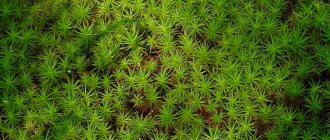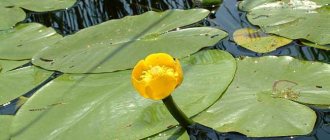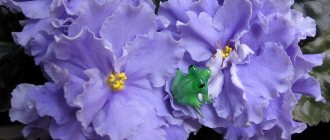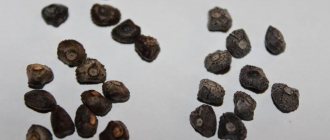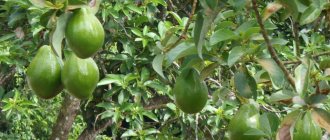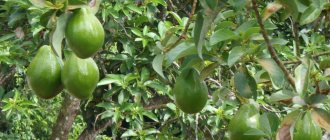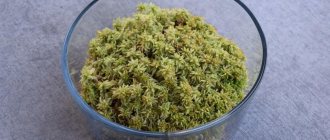- November 24, 2018
- Wild plants
- Michael
Probably, many readers have heard about such moss as sphagnum. It is not surprising - it is found in many regions of our country and is actively stocked by experienced flower growers. And in general, the scope of its application is quite wide. Therefore, it will be useful to tell you how sphagnum moss is used and where it grows. The photos attached to the article will allow you to learn more about him.
Appearance
Now it’s worth telling what sphagnum moss looks like - the photos still give only a fairly superficial idea.
He cannot boast of a particularly outstanding appearance. It has a very thin green stem that starts at the root and stretches upward. It is distinguished by its emerald green color. The upper part is covered with small leaves arranged in a spiral. By the way, for the sake of clarity, it should be noted that this moss actually has no roots. And that brown part, which not very experienced botanists perceive as a root, is an old, dead part of the plant.
Sphagnum, despite its small size, is a perennial plant. As cold weather approaches, it freezes to continue life in the spring. It only grows upward, not sideways. The lower part dies over time, rots, becoming peat.
The stems grow very densely, most often in damp places. Because of this, only the upper part receives the light necessary for the development of green plants. And in the lower, shaded area, chlorophyll is destroyed over time, and it becomes white. Over time it rots, turning brown.
It reproduces, like most mosses, with the help of spores. They contain germ cells grown on the stem. After ripening, the sac bursts, and thanks to water and wind, light spores are carried over a considerable distance.
Options for using sphagnum
Sphagnum moss is used in construction, folk medicine, beekeeping, animal husbandry, etc. But let’s take a closer look at why flower growers, as well as those who have a garden or vegetable garden, should prepare or buy sphagnum.
Sphagnum moss in indoor floriculture
Every indoor plant lover has used sphagnum moss at least once or heard about it. And if you grow orchids at home, most likely you have several bags of this valuable natural material in stock. There are many options for using moss in indoor floriculture.
- Filler for composite earth mixtures . Thanks to the addition of sphagnum, the hygroscopicity, breathability and acidity of the soil increases. The soil retains moisture without being waterlogged. The root system receives as much fluid as it needs, while maintaining the ability to breathe.
- Surface cover of soil in pots . This is especially true for moisture-loving plants. Moss maintains optimal soil water balance for a long time. Sphagnum on the surface of pots is one of the secrets of those who want to provide sufficient moisture to plants during long trips from home.
- Soil sterilization . Thanks to its bactericidal and antiseptic properties, this moss protects plants from pathogenic microflora. It can be added to sterilize the earthen mixture.
- Drainage . Sphagnum moss is placed at the bottom of the pot to create a drainage layer. It absorbs excess moisture after watering, and, if necessary, releases moisture back to the soil. Compared to expanded clay, moss takes up less volume and saves pot space.
- Making blocks for epiphytes . Using sphagnum moss you can create hanging baskets, supports and blocks for aerial rooted plants.
- Rooting cuttings . Cuttings (for example, violet leaves) can be rooted in moss. Or you can tie plants with thick stems without lower leaves with a film of wet sphagnum (a cut is first made on the stem). This method is also used for cutting roses.
- Air humidification . If the plant loves moist air, place the pot in a wider pot or bowl, on the bottom of which lay expanded clay (bottom layer) and sphagnum (top layer). It is desirable that the moss be alive. By spraying it in the morning and evening, you will significantly increase the air humidity.
- Filtration of hard water . By watering indoor plants through the top layer of moss, you remove salts from hard tap water. At the same time, do not forget to change the natural filter from time to time.
- Disguising bare stems . The stems of some plants become elongated and unattractively exposed at the bottom. Wrap them in sphagnum moss, securing the moss with wire. This will make the plant look better. This wrap is especially useful for flowers with air horses.
It is worth buying sphagnum moss if you grow the following indoor plants: azalea, anthurium, asparagus, begonia, dracaena, dieffenbachia, monstera, orchids, crassula.
Sphagnum moss for the garden
ju-bryophytes.blogspot.com
For gardening and vegetable gardens, sphagnum moss is used less often than for indoor floriculture. One of the reasons is that not everyone knows what benefits can be derived from this natural material.
- Covering material . With the help of sphagnum you can protect tender plants from frost, because... it retains heat perfectly. It is also used to wrap the trunks of trees susceptible to cold.
- Fertilizer . Sphagnum itself contains virtually no nutrients, but when it dies it forms peat.
Use sphagnum to enrich the soil with caution. Sphagnum peat increases the acidity of the soil, and this is not suitable for all crops.
- Decorative solution . Use moss to decorate alpine slides or ordinary flower beds. It is both beautiful and original.
- Mulch . Sphagnum is suitable for mulching. But keep in mind that under a layer of moss the ground will be several degrees colder. At the same time, such mulch retains the warmth of the earth in cold weather and protects against excessive heat in hot weather.
Do not use sphagnum moss to mulch beds with small-fruited or garden strawberries (strawberries). These crops will rot under a layer of moss. But for peppers, radishes, raspberries and potatoes, this mulch is ideal.
- Protection against rot during crop storage . Layer roots and bulbs in layers of sphagnum moss for long-term storage. This will protect them from mold and rot. In addition, the loose structure of moss promotes air circulation.
- Germination of seeds . The nutritious, moist environment that can be created with sphagnum moss is optimal for germinating seeds of any crop.
Where is it found?
Now it’s worth telling how to find sphagnum moss in nature - photos will help you easily identify it.
This valuable plant is most often found in the north of our country. Moreover, mainly in forest thickets, where high soil moisture is provided by small rivers and lakes, as well as streams and swamps.
Sphagnum is surprisingly unpretentious. Even weak, diffused sunlight is enough for it to develop successfully. In addition, it grows well on all surfaces: stones, clay, trees, earth, even glass and iron.
However, if we tell you where sphagnum moss grows in Russia, a photo of which is attached to the article, then it is worth noting that it can also be found in the steppe. But this place should be very wet - for example, somewhere near streams or lakes.
Where and how to collect sphagnum
Sphagnum is a safe plant, non-toxic and has no thorns. You can assemble it without gloves or a shovel, as it can be easily pulled out of the ground.
It is better not to tear it out completely, but to cut off the upper part with a knife or scissors. This is due to the fact that the collected moss will not be contaminated and renewal will occur faster at the place where it was collected. These measures are very important for preserving natural areas where white moss grows.
When young shoots appear on the cut sphagnum, the plant can be used.
Sphagnum is often found in wet, wet areas, in forests on the banks of streams, and near lakes. Distributed in the northern regions of Ukraine and Russia.
How it is used
Not every person who has seen a luxurious sphagnum carpet in the forest realizes how wide the scope of this amazing plant is. But people have learned to use it in construction, crop production, cosmetology and even medicine.
Thanks to a number of features, moss becomes a truly unique material. To begin with, it should be noted that it perfectly allows air to pass through, absorbing excess moisture from it, and dry, on the contrary, moisturizes to a comfortable level. Experts say that moss absorbs a huge amount of moisture - 20 times more volume than it has itself! Can any other material boast such an indicator of moisture absorption?
It is also very important that it has antiseptic properties. This allows it to be used in medicine, mainly in extreme medicine.
However, in order for the reader to better understand the topic, it is worth giving a few specific examples.
How to grow sphagnum
Reproduction of living sphagnum moss can be observed most often in the wild. Growing sphagnum moss at home is a very labor-intensive cycle that rarely ends in success. If you brought home source material, remember:
- Sphagnum moss grows better in a container with distilled water; tap water will destroy it. You can use rainwater or melted snow.
- Cover the container with the moss you are growing with film, this will slow down the evaporation of moisture and create a greenhouse effect.
- Maintain the temperature, it's about 20 degrees.
- Place the container with moss in the northern part of the room, where there is little light.
Why do flower growers need it?
Most often, when talking about the use of sphagnum moss, a photo of which is attached to the article, people remember indoor plants. It is really actively used in caring for flowers.
First of all, it’s worth talking about help with seed germination. They need to be kept in a humid environment. However, fabric, not to mention paper, dries very quickly. You have to moisturize it every day, and sometimes several times a day. Sphagnum moss solves this problem - moisten it generously and wrap the seeds in lush greens. After that, you can forget about them for several days. The moss will quickly absorb excess moisture, so rot does not threaten the seeds. But then it will give them excess moisture and they will not dry out.
Due to this same effect, moss is actively used when caring for plants in pots. You need to lay a thick layer of sphagnum directly on the soil, after which you can water the flowers not daily, but once a week. At the same time, moss will protect plants from bacteria and infections that carry diseases. It has long been noted that sphagnum, which has antiseptic properties, does not allow the appearance of mold and fungi in its vicinity.
In addition, the soil underneath becomes looser and softer. As a result, it is better saturated with oxygen, and the plant grows faster.
In addition, with the active growth of moss, its lower part will die off, this has already been mentioned above. As a result, dead areas turn into peat - an excellent fertilizer for any plant.
Methods of use
There are different ways to use it, here are a few of them:
Adding to Soil
As already mentioned, sphagnum makes the soil loose, light and regulates moisture. You need to know some rules of use: white moss in the soil should be no more than 10 percent, since the plant increases the acidity of the soil. But you should also remember that, for example, it will be very useful for violets.
Use for tubers and bulbs
White moss can be used to wrap tubers and bulbs of heat-loving plants. This will protect them from rotting and drying out for a long time. Flowers will survive until spring planting, because they will not be afraid of gray rot and mold.
Lining the pot
Lining a flower pot with sphagnum moss is usually used for flowers that require high humidity. Moss retains moisture in the soil well, and some of the water evaporates, giving moisture to the crown, which also has a good effect on the plant. However, this method should not be used for ordinary flowers; too much moisture can harm them. But, for example, when planning a trip for a week, moss can be very useful. By covering the soil and watering the flower, the moisture will remain in it for another 7-10 days.
Rooting cuttings and leaves
Rooting with the addition of sphagnum moss to the soil (1:1) prevents rotting of cuttings and leaves. Then, when transplanting, moss is used in a ratio of 1:3. This method is most often used when it comes to orchids and violets. On the contrary, this method will not work for succulents.
Application in medicine
Historians are well aware that during terrible wars like the Great Patriotic War, sphagnum saved the lives and health of many soldiers and officers. There was a catastrophic shortage of simple antibiotics, bandages and cotton wool, so experienced doctors used sphagnum moss. Clean bundles were placed directly on the wound, after which they were rewound with any fabric, often not even sterile. Sphagnum destroyed harmful bacteria around it. Thanks to this, the wounds healed faster. It is no coincidence that earlier detachments were formed from pioneers and Octobrists, which prepared this raw material and sent it to the front.
It can also be used at home. Do you suffer from nail or foot fungus? Put some moss in your shoes and solve this problem forever. Moreover, without purchasing expensive drugs with questionable effectiveness.
You can take baths with sphagnum moss. Steam 100 grams of moss with three liters of boiling water, leave overnight and pour into a bathtub filled with warm water. Two half-hour procedures a week (just lie in the bath) and arthritis and arthrosis will recede, sweating will improve and excess salt will be removed from the body.
How can you use sphagnum moss?
The beneficial properties of unusual peat have been known for a long time. It has found wide application in various areas of human activity.
For the production of alcohol
Various types of alcohol are obtained from young sphagnum moss. It is placed in an autoclave. Inside the device, under pressure and the action of sulfuric acid, it turns into a sugary solution. The latter is fermented with yeast. From one and a half thousand kilograms, approximately 5 buckets (about 50 liters) of ninety-proof alcohol are obtained.
In medicine
The medicinal properties of a plant are determined by its composition. It is rich in sugars, cellulose, coumarins, phenol-like and triterpene compounds, pectin elements, mineral salts, and resins.
Sphagnum has the following beneficial effects:
- due to its antibacterial properties, it began to be used to combat nail fungus;
- accelerates the healing of purulent, cut, open wounds;
- is an excellent antiseptic for dressings without the need for sterilization;
- eliminates staphylococcal lesions.
There are many recipes for potions that have been tested for decades.
For bedsores
The only one of the most complex, but truly effective recipes. To prevent bedsores from occurring in bedridden patients, they sew a special mat from flax and stuff it with moss. Products are stitched in strips 40-50 mm wide.
Sphagnum
For osteochondrosis, radiculitis and rheumatism
The use of moss against these ailments involves:
- Taking a bath with a solution of one part of dry moss, infused at room temperature with ten parts of boiling water until cool, which is then filtered. You need to lie in the water for no more than 40 minutes.
- Applying a compress moistened with brewed raw materials. Add a tablespoon of peat to half a liter of boiling water. The composition is pre-filtered.
Both procedures are equally effective.
Beautiful phacelia flower.
For cuts and burns
To make the wounds heal faster, apply a paste of dry raw materials poured with boiling water. Proportions don't matter much. A powder of peat, ground to powder, helps with burns and is washed off a few minutes after application.
For dermatological problems
The following remedies help with skin diseases:
- Infusion. In equal parts, take clover, galangal (root), verbena leaves, primrose, dried grass, stockrose, gravel, and sphagnum peat moss. Add 10 g of the mixture to half a liter of boiling water, leave for 2 hours and drink a quarter of an hour before a meal or in the form of applications applied for 20-25 minutes.
- Ointment. Melt Vaseline in a water bath and mix in equal proportions with sphagnum. The product is especially effective for fungal infections and rashes.
Use the products until problems with the dermis are eliminated.
In floriculture
It is familiar to summer residents as a winter shelter for crops that are not resistant to frost, fertilizer, and a filler for forcing young seedlings. It can be used for the following purposes:
- cultivating young and rescuing specimens suffering from various ailments;
- ensuring the hygroscopicity of various substrate compositions;
- growing orchids.
In the latter case, sphagnum serves as a nutrient soil until the orchid's root system becomes strong enough that the flower can be replanted in a permanent soil mixture.
Growing moss
Not everyone knows that sphagnum can be cultivated at home, and the procedure is surprisingly simple. It is enough to have at least a small piece of moss - you can find it in the forest, take it from friends or purchase it in a special store.
First, the sphagnum moss needs to be washed. To do this, soak it in warm water (preferably settled) and leave for half a day. Every few hours the moss needs to be lightly shaken to remove debris, soil and sand. After the time has passed, carefully remove the thin stems and pour out the dirty water.
Now you can start growing the plant. Place it in a three-liter jar or small aquarium. Pour some water, close the container and leave in a sunny place. During photosynthesis, oxygen will be produced, and dead stems will serve as a substrate and source of carbon dioxide. This will create a closed ecosystem from which you can sometimes take some of the moss and add a little water.
How to prepare sphagnum yourself?
Sphagnum moss is harvested in August-September. Moss brought from the forest must be squeezed out of excess water, and tangled debris and insects must be removed from it. Then the sphagnum is laid out on a bed of lutrasil or spunbond in partial shade and turned over regularly. Dried sphagnum moss is stored packed in a plastic bag in the vegetable section of the refrigerator or in a cool basement. Before use, it must be wetted and squeezed out; it is also recommended to disinfect it: sphagnum has bactericidal, but not insecticidal properties, and eggs or insect larvae can be preserved in it. To disinfect, moss is placed in a colander and doused with boiling water.
sphagnum moss collected from a swamp in the Moscow region
Harvesting sphagnum
If you find a variety of sphagnum moss in the forest (photos will help you identify it), then you can stock it for future use. It is best to collect valuable raw materials near streams or lakes in well-shaded places - these are ideal conditions, which means the plant will be of the highest quality.
You can collect all the moss along with the “roots”, then the process goes much faster. In addition, peat fertilizer will form faster, which is important for many gardeners.
Or you can carefully cut off the top green layer using simple scissors, leaving the white and brown in place. In this case, you will get a smaller volume of moss, but it will be alive and will be able to grow perfectly, quickly increasing in your small plantation.
Botanical description of sphagnum
This moss belongs to the Sphagnum family. The name “White Moss” is also found in the literature. The plant was nicknamed this because of its ability to change color when it dries - it turns from green to white.
It absorbs water over its entire surface, has no roots, and is attached to the soil by the lower part of the stem. Like all mosses, it is very tenacious and unpretentious to living conditions.
The plant reaches a height of up to 20 cm, the stem is branched. The leaves are small, without veins, light green.
Sphagnum reproduces through the fusion of antheridia and archegonia, which are located at the tops of individual twisted stems. After fusion, a sporophyte is formed.
We store it correctly
The rules for storing moss depend primarily on how you plan to use it.
Do you need dry sphagnum moss used in medicine? Then the easiest way is to use a cord or strong thread and hang the stems in a thin layer in a warm place with good ventilation. Well, or at least spread it out on a towel or newspaper and leave it on a windowsill well lit by the sun. Stir the moss a couple of times a day to ensure it dries evenly. Otherwise, the top will dry out and form a crust. Inside, the stems will remain damp and over time, mold may appear here, making the use of moss for medical purposes impossible.
A completely different storage method should be chosen if your goal is to keep it alive for the longest possible period. Coping with this task is not at all difficult. Rinse the moss well, then place it in a paper or cloth bag and place it in the refrigerator or freezer. In such conditions, it can easily be preserved for several years. When you need sphagnum moss, simply remove it from the refrigerator and leave it in a warm, slightly humid place. After a few hours, the stems will thaw, and after a few days they will continue to grow as if nothing had happened. But here it is worth considering that the longer the sphagnum lies frozen, the fewer stems will remain alive. It is advisable to remove the rest as soon as it becomes clear that they are dead. This is not difficult to determine - they dry out quite quickly.
Harvesting and storage of sphagnum
- On large plots of moss, cut off the top part or pull it out of the ground and shake it out.
- If the moss is very wet, squeeze it out a little. It should remain moist but not wet.
- At home, we spread the sphagnum moss on the work surface, remove unnecessary elements, spread it evenly, dry it for several days, periodically turning it over and shaking it.
- Live sphagnum moss can be distributed into plastic bags in portions and stored in the freezer. At the same time, it retains its beneficial properties to the fullest.
How to properly collect and store moss
White moss should only be collected that grows in swamps. It is not recommended to pick plants with a bottom cushion, as this can destroy a large amount of sphagnum. It is safest to cut off the top green part with a sharp knife.
The harvested raw materials should be sorted, removing all insect larvae. Then thoroughly rinse with boiling water and place on a paper or linen towel. It is recommended to dry sphagnum in the shade with minimal humidity.
Drying moss in an electric dryer is not recommended, as it will not be possible to obtain high-quality raw materials.
Finished raw materials should be kept only in bags made from natural materials. The storage place should be dry and dark. An excellent option is the pantry, the top shelf of the kitchen cabinet.
Sphagnum moss is a unique plant. When used correctly, it can relieve many diseases. The main thing is to follow simple recommendations, then achieving the desired result will not be difficult.
The use of sphagnum moss in construction
The special properties of sphagnum allow this moss to be used not only in medicine, but also in many other areas of human activity, for example, in construction. Surely everyone knows that when building wooden houses you need insulation, which is placed between the logs. Now in the construction markets there is a huge selection of a wide variety of insulation materials, including synthetic ones. But if you want your house or bathhouse to last for many years, then it is best to take sphagnum. Firstly, this moss has a bactericidal property, and the log house will last much longer and will not rot. Secondly, if you are building a bathhouse, then the hygroscopic properties of this moss allow you to smooth out changes in humidity, and this will also help ensure that the bathhouse will last much longer.
Beneficial properties of sphagnum moss
From a medical point of view, sphagnum has three very important properties. Firstly, it is highly hygroscopic, that is, the ability to absorb moisture. For comparison, the same volume of sphagnum moss and cotton wool will absorb different amounts of moisture. If you measure these data, it turns out that sphagnum absorbs 20 - 25 times more moisture than cotton wool. The second property of sphagnum is its breathability; even when wet, this moss allows air to pass through very well, whereas cotton wool, for example, sticks together and forms a certain crust. And the third property is antibacterial.
The ability to absorb huge amounts of moisture is due to the cellular structure of this moss. If you look at a moss leaf under a microscope, you can see that in addition to the usual green cells that contain chlorophyll and in which photosynthesis occurs, just like in any other green plant, there are special air-bearing cells. They will be dead and their shells will be quite dense. If you take dry moss and examine it, these cells will be filled with air, but when we soak it, these cells are filled with water and are capable of holding a huge amount of moisture. High hygroscopicity allows the use of sphagnum as a dressing. In partisan detachments during the Second World War, military doctors used it instead of cotton wool during surgical operations. It absorbs huge amounts of blood, pus and other fluids. Moreover, it was used not only during the war, but now doctors are increasingly resorting to this remedy. But unlike cotton wool, for example, sphagnum also has antibacterial and disinfecting properties. The antibacterial, disinfectant and even antifungal properties of sphagnum are due to the substances that are included in its composition. First of all, it is a phenol-like substance called “sphagnol”. This substance was not isolated in other plants, only in sphagnum, and, of course, humic or sphagnum acids exhibiting antibiotic properties. For a long time they tried to figure out what is the best solvent for these substances and how best to extract them from plants. We used a variety of substances - water, ethanol, ether, but found that the best solvent was ordinary distilled water. It is this property of water to act as a solvent and absorb all the beneficial substances contained in sphagnum that allows some experts to claim that the cleanest water in the forest is swamp water. Therefore, if you find yourself in a forest in the area of a raised bog and find dark, unpleasant-looking water, do not be afraid; most likely, you can drink it after boiling it first. The bactericidal properties of sphagnum can be used not only for cuts, but also for burns and frostbite, and for menstruation in the form of pads. Many people know what needs to be done in the event of a fracture, say, of a limb. It is necessary to apply a splint and transport the patient to a medical facility. But few people know that the splint should not be placed directly on the body. Some kind of softening pad is needed and in this case sphagnum is ideal. In addition to the fact that it will soften possible impacts and friction between the tire and the skin, it will also act as a disinfectant if there is any surface damage. There is evidence that sphagnum moss has been used as a dressing since the 11th century, and possibly even earlier. But even in our 21st century, modern medicine comes to the conclusion that sphagnum is a more effective remedy than, for example, cotton wool and the production of sphagnum-gauze tampons is being resumed. To do this, sphagnum is additionally sterilized and impregnated with a solution of boric acid, which further enhances its antibacterial properties. But at home you can use non-sterilized sphagnum moss. There are a huge number of different microorganisms flying around us in the air, including staphylococcus. So it is safe and harmless for us, but as soon as our immunity weakens a little, it immediately sits on our skin and begins to multiply, thereby bringing a lot of trouble. How to avoid this and how to deal with it? Peat water is ideal for this. Simply squeeze out the moss collected from the swamp and rinse the affected areas with this water. Or apply wet moss to the place where you have a similar infection. In addition, you can take a bath with sphagnum moss. To do this, cut the sphagnum into small pieces, fill it with hot water at 70–80 °C, allow it to cool and then pour the infusion into the bath. But keep in mind that taking such a bath increases sweating and after that you need to wrap yourself in a warm bathrobe or lie down under a blanket. The antibacterial and antifungal properties of sphagnum can also be used to combat fungal skin diseases. An excellent remedy is sphagnum insoles. You can make them yourself by simply putting a little dried moss in your shoes. Firstly, the insole will be soft, comfortable and will fit your foot; in addition, sphagnum moss will help cope with increased sweating and avoid unpleasant odors.
